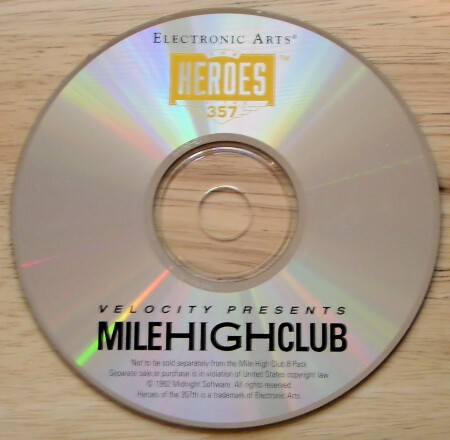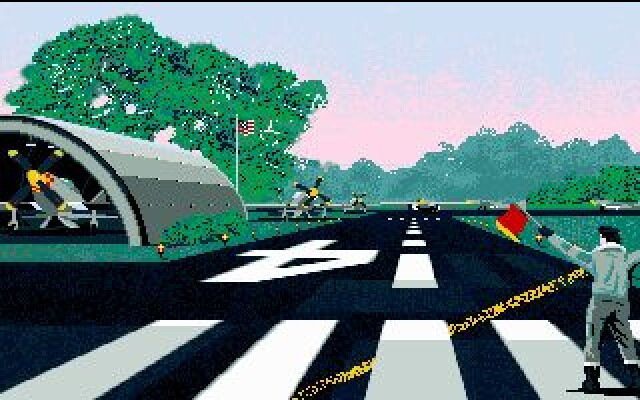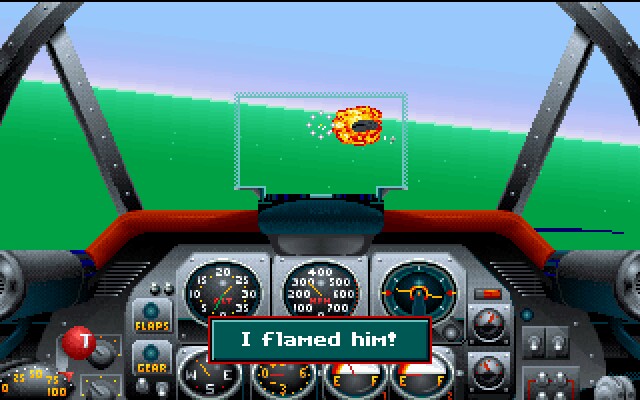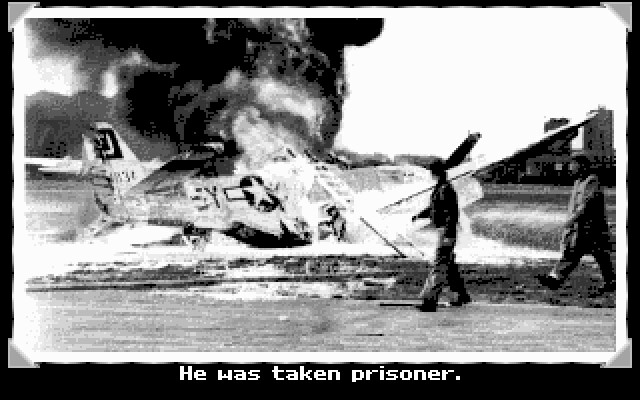
Actual Game
Heroes of the 357th1-Click Install
|
The Game
The game is based on the actual missions of one of the top fighter groups of World War II, Heroes of the 357th was one of the few flight combat sims of the 90s to combine historical accuracy with challenging gameplay. Heroes allows you to enlist the 357th fighter group and fly with aces like Leonard Kit Carson and Bud Anderson in a fight for the sky against the Luftwaffe. The game features are right inline with 1990s era flight combat sims:
The Origin of the 357th
There can be no doubt that America's entrance into the European theater during World War II hastened Germany's demise, if not thwarted Hitler's dream of global domination. For the first time in military history, air superiority" was tantamount to victory. Whereas in the Great War legendary pilots fought many uncoordinated and largely insignificant skirmishes in the skies above the armies, the pilots, gunners, and bombardiers in World War II manned aircraft of great speed. with the power to cause massive destruction, Gone were the days of chivalrous knights jousting for honor and glory in motorized kites, while on the battlefields below enemies and compatriots alike died by the thousands of disease, starvation, exposure, and battle wounds. Now air forces had a potent hand in ending conflicts and sparing lives. And the primary role of fighter pilots in World War II was to escort bombers safely to strategically selected targets, where the bombers would attempt to destroy the enemy's ability to make war.
When the U.S. Air Force arrived in Europe in 1942, Britain's beleaguered Royal Air Force was barely holding its own against Goering's indomitable Luftwaffe. But a few years later the Luftwaffe was so crippled that it could offer only a token resistance to the Allies' unremittent bombing runs. During the last year-and-half of the war, one fighter group of America's 8th Air Force distinguished itself as most formidable - the 357th - known to friend and foe alike as "The Yoxford Boys".
The 357th began operational training officially on December 1, 1942 at Hamilton Field on the shore of San Pablo Bay, just north of San Francisco. Four of the officers assigned early in the training period were to remain with the Group throughout most of its existence: Major Donald Graham, Major Robert Romaine, Captain Alfred Craven, and Captain Irwin H. Dregne. Combat elements of the Group consisted of three fighter squadrons: the 362nd, 363rd, and 364th. In command of the squadrons were Major Hubert I. Egnes, Captain Stuart R. Lauler, and Captain Varian E. White, respectively. That two of the three commanders - Egnes and White - were combat veterans was a rare distinction indeed for such an embryonic unit. The original cadre had little to work with apart from the men themselves. There were no aircraft at all, nor vehicles of any kind for that matter; and office furniture consisted of empty crates. The Group was not intended to do any flying from Hamilton Field. Nonetheless, the 357th began to take shape.
In March of 1943, the Group now formed into some semblance of order, the 357th was transferred to the desolate surroundings of the Army Air Base at Tonopah, Nevada for in-flight training. It should be noted that during World War II more American pilots died (and more aircraft were lost) in training than in actual combat; and 357th's stint in Tonopah bears that out. In a one month period during June and July, there were eight training fatalities and numerous hail-outs and ground accidents. The frequency of such calamities soon decreased, and by the end of the summer the pilots and ground crews had gained the experience it would take to make a first-class fighter group.
In October, for their last phase of training before transferring to overseas for combat duty, the Group's three squadrons were separated. The 362nd went to Pocatello, Idaho, the 363rd to Ainsworth, Nebraska. and the 364th to Casper, Wyoming. It was at these three bases that the pilots learned to serve as escorts to bombers, mostly B-24s. This would be their primary function. It's important to note that such a protracted and specified training regimen proved instrumental for the United States Air Force's success against the Luftwaffe. While it was important to join in the war against Hitler without adieu, it was necessary to make sure that the pilots and attendant ground-crews maintain a high level of excellence. Indeed, the Allies pressed the war to its conclusion by bombing Germany's petroleum refineries; and the Luftwaffe Command, short on fuel for training operations, sent up young, poorly-trained, though well-indoctrinated Nazi flyers to combat well-trained American fighter pilots. This flict accounts, at least in part, for the astounding success of the 357th Fighter Group in Europe.
On December 7th, trained exclusively in the now somewhat obsolete P-39. the pilots of the 357th arrived at a newly constructed airbase in Raydon Wood, County Suffock, England. The group commander was Lt. Col. Edwin S. Chickering. Once in place, the Group was assigned to General Lewis H. Brereton's 9th Air Force under the 700th Fighter Wing as part of the IX Fighter Command. The first North American P-51B Mustangs began to arrive a few weeks later, painted olive-drab. The Royal Air Force (RAF) had been using the American designed P-51 for some time, but for the pilots of the 357th it was a new species altogether. The Mustangs were slow in arriving, and while the pilots waited for their mounts, they took ground-school courses in aircraft identification, communications, and weather conditions.
By New Years Day , the 357th had 15 P-51Bs. The principle virtue of the B series was its improved power plant: the Packard-built Rolls Royce Merlin. These superb motors offered superb high-altitude performance. Soon the pilots of the 357th would get a chance to show their stuff...







